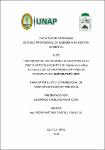Influencia de las raciones alimenticias en el crecimiento de neonatos de Caiman crocodilus (Linnaeus 1758) en cautiverio con fines de conservación. Iquitos, Perú. 2020
Abstract
The study was carried out in the Temporary Custody Center and Zoo “Fundo Pedrito”, in the Barrio Florido town center, district of Punchana, it is an experimental quantitative research, the Completely Random Design (DCA) was used with nine units. experimental experiments distributed randomly to determine the influence of food rations on the biological development of Caiman crocodrilus neonates) for four months. T1 was the one that obtained the greatest increases from 7.0 g to 11.20 g, followed by treatment T0 between 4.30 g and 6.50 g. and the one that obtained the smallest increases are those in treatment T2 with 3.0 g to 4.0 g. Regarding the total length of the neonates, treatment T1 reached an average total length of 17.47 cm, followed by T2 with an average of 15.89 cm and finally T0 with 14.9 cm. In the analysis of variance, the total length indicates a significantly high statistical difference between the treatments, the treatment that most influences the growth of the neonates is T1 (fed with fish) with an average of 17.47 cm, statistically surpassing the others. treatments, the relationship coefficient shows a low intermediate level of association of 44.25% between total length and food consumption. Regarding the average weights, in T1 they reached a highest average weight of 46.44 g, followed by T2 with a weight of 45.67 g, while T0 with 34.78 g obtained the lowest weight. The analysis of variance of the weight averages shows that There is no statistical significance, since Fc= 0.15279133 is less than Ft=5.14325285. While the analysis of variance of food consumption shows a high significant statistical difference between treatments, since Fc=49.20941098** is greater than Ft=18.51282051, so the Duncan test indicates that the averages of treatments T1 and T2 are absolutely discrepant among themselves, where T1 occupies the first place with an average of 599.66667 g, statistically surpassing T2 who occupied the subsequent position with an average of 260.3333333 g, the control did not prosper, these variables show a moderately high level of correlation of 79.08% of association between total weight on food consumption in neonates. El estudio se realizó en el Centro de Custodia temporal y Zoológico “Fundo Pedrito”, en el centro poblado Barrio Florido”, distrito de Punchana, es una investigación cuantitativa de tipo experimental, se utilizó el Diseño Completamente al Azar (DCA) con nueve unidades experimentales distribuidas al azar para determinar la influencia de las raciones alimenticias en el desarrollo biológico de neonatos de Caiman crocodrilus) durante cuatro meses. El T1 fue el que obtuvo los mayores incrementos desde 7.0 g a 11.20 g., seguido del tratamiento T0 entre 4.30 g a 6.50 g. y el que obtuvo los menores incrementos son los de tratamiento T2 con 3.0 g a 4.0 g. Sobre el largo total de los neonatos, el tratamiento T1 alcanzaron un largo total promedio de 17.47 cm, seguido por el T2 con promedio de 15.89 cm y en ultimo ligar el T0 con 14.9 cm. En el análisis de varianza, del largo total indica una alta diferencia estadística significativamente entre los tratamientos, el tratamiento que influye más en el crecimiento de los neonatos es el T1 (alimentados con peces) con un promedio de 17.47 cm, superando estadísticamente a los demás tratamientos, el coeficiente de relación muestra un nivel intermedio bajo de asociación del 44.25 % entre el largo total y consumo de alimento. Sobre los pesos promedio, en T1 alcanzaron un mayor peso promedio de 46.44 g, seguidos por T2 con un peso de 45.67 g., mientras que el T0 con 34.78 g obtiene el menor peso, El análisis de varianza de los promedios de peso muestra que no existe significancia estadística, puesto que Fc= 0.15279133 es menor a Ft=5.14325285. Mientras que el análisis de varianza del consumo de alimentos muestra una alta diferencia estadística significativa entre tratamientos, puesto de Fc=49.20941098** es mayor a Ft=18.51282051, por lo que la prueba de Duncan, indica que los promedios de los tratamientos T1 y T2 son absolutamente discrepantes entre sí, donde T1 ocupa el primer lugar con promedio de 599.66667 g superando estadísticamente a T2 que ocupó el puesto subsiguiente con promedio de 260.3333333 g, el testigo no prosperó, estas variables muestran nivel de correlación medianamente alto del 79.08% de asociación entre el peso total sobre el consumo de alimento en neonatos.
Collections
- Tesis [501]


